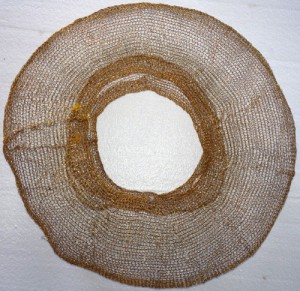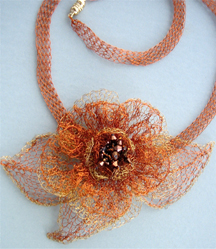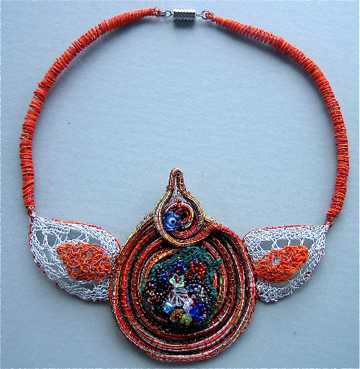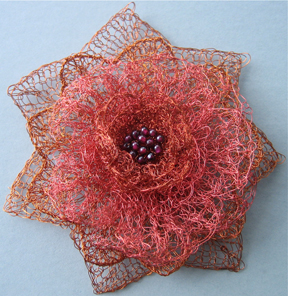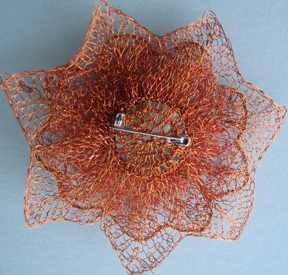It is possible to construct topological shapes via knitting. In HK this may be done on circulars. One out of many tutorials may be found here, and the mathematical knitting is a very good, extensive resource.
Tag: copper wire
Staying botanical
Love in an uncertain world
A new/different direction from other neckpieces, my first with a “story” open to interpretation; it is composed of coiled, knit, crocheted, and stitched telephone and magnet copper wire, assorted beads, a couple of acupuncture needle covers, the cut/ partially frayed “heart” of an unfinished spirit doll, and a screw closure. It is also considerably more of a “burden” than the featherweight magnet wire cousins, weighs in at 3.5 oz./88 gms.
The latest in collar country
In anticipation of the fiber invitational in Lowell and the annual Art to Wear show at Cambridge Artists’ Cooperative, the copper wire is resurfacing in new neck pieces. Some of the presently completed work may be seen below. Materials often come with their own stories. I purchased my nearly invisible wires from an elderly gentleman at a RI yard sale years ago for only a few dollars. He in turn had worked using them on TV and radio tubes in the “old days”. The 32 gauge version was obtained with the assistance of a brother-in-law-electrician. A beaded piece is “in the works”, and then there is all that colored telephone wire and a shoebox full of acupuncture needle cases periodically calling out to me… I tend to work freeform, without sketching, piecing elements and working out designs and problems as I go. There are elements of surprise for me as well in each piece I create.
The beginning of a new/different direction
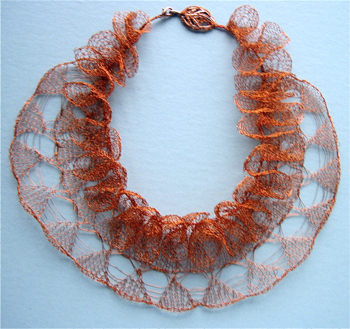 ladder lace and short rowed ruffles, modified commercial toggle closure
ladder lace and short rowed ruffles, modified commercial toggle closure
The finished collar tuck lace and ruffle collar; 4 strands of nearly invisible wire used throughout
Trying to coax a rectangle into a square.
Blocking is one of those topics open to endless debate both as to method and necessity. In most of the items I produce using conventional yarns, I restrict it pretty much to washing/pressing/ironing as needed, thus avoiding all those blocking wires, pins, etc. In this instance, however, the wire item is in need of some help in changing into and retaining the desired shape: my partial solution is seen in the photo above.
For the curious: Magnet wire or enameled copper wire is a copper or aluminum wire covered with thin insulation. It is used in the construction of transformers, inductors, motors, headphones, loudspeakers, hard drive head positioners, potentiometers, and electromagnets, among other applications. However, it is not usually magnetic itself. Magnet wire insulating films used (in order of increasing temperature range) include polyurethane, polyamide, polyester, polyester-polyimide, polyamide-polyimide (or amide-imide), and polyimide. Kynar wire is an instance of a color-coated member of these families and is used in my “colored” jewelry items. For knitting on a loom, I prefer 32 gauge or thinner (higher numbers), which can be plied successfully for more drape but are nearly invisible singly; 30 gauge or less(lower numbers) moves into the hand crochet/knit coil domain for me.
I enjoy using materials designed for uses other than those for which they were designed, the inherent challenge, surprises, and problem-solving.
